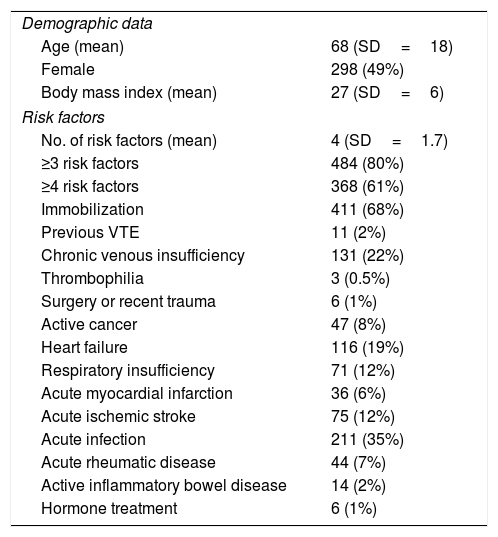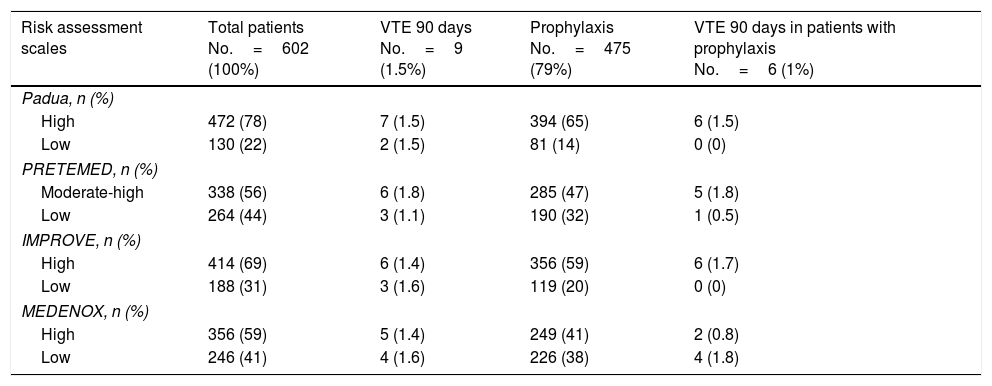There are a lot of venous thromboembolism risk assessment models with the aim of predicting the individual risk of venous thromboembolism (VTE), although most have not been externally validated. The objective of our study was to analyze the concordance among the Padua, PRETEMED, IMPROVE and MEDENOX scores.
Patients and methodsObservational cohort study with 602 patients admitted to Medical Services of the Hospital Universitario Santa Lucía. Concordance was calculated using the kappa index (KI) between the four risk prediction scales and the VTE occurring within 90 days of hospitalization.
ResultsPatients considered were those with a high risk of VTE, 78%, 56%, 69% and 59% according to Padua, PRETEMED, IMPROVE and MEDENOX scores respectively. A KI=0.60 was observed among Padua-IMPROVE scores; KI=0.44 among IMPROVE-PRETEMED, KI=0.43 among PRETEMED-MEDENOX, KI=0.33 among Padua-PRETEMED, KI=0.27 among IMPROVE-MEDENOX and a KI=0.24 among Padua-MEDENOX. During follow-up, nine cases of VTE (1.5%) were observed.
ConclusionsThe highest degree of agreement was observed among the Padua and IMPROVE scores. There is no good agreement between any of the predictive risk scales for VTE in medical patients. The Padua score was the best predictor of VTE episodes at 90 days among high risk patients.
Existen numerosas escalas cuyo objetivo es predecir el riesgo individual de enfermedad tromboembólica venosa (ETV), si bien la mayoría de ellas no se han validado externamente. El objetivo de nuestro estudio fue analizar la concordancia entre las escalas de Padua, PRETEMED, IMPROVE y los criterios de inclusión del estudio MEDENOX.
Pacientes y métodoEstudio observacional de cohortes con 602 pacientes ingresados en servicios médicos del Hospital Universitario Santa Lucía. Se calculó la concordancia mediante el índice kappa (IK) entre las 4 escalas de predicción de riesgo y se recogieron las ETV ocurridas en los 90 días siguientes a la hospitalización.
ResultadosSe consideraron pacientes de alto riesgo de presentar ETV el 78, 56, 69 y 59% de los pacientes según las escalas Padua, PRETEMED, IMPROVE y MEDENOX, respectivamente. Se observó un IK=0,60 entre las escalas Padua-IMPROVE; IK=0,44 entre IMPROVE-PRETEMED, IK=0,43 entre PRETEMED-MEDENOX, IK=0,33 entre Padua-PRETEMED, IK=0,27 entre IMPROVE-MEDENOX y un IK=0,24 entre Padua-MEDENOX. Durante el seguimiento se observaron 9 casos de ETV (1,5%).
ConclusionesEl mayor grado de concordancia se determinó entre las escalas Padua e IMPROVE. No existe buena concordancia entre ninguna de las escalas de predicción de riesgo de ETV en pacientes médicos. La escala Padua fue la que mejor predijo los episodios de ETV a los 90 días entre los pacientes clasificados de alto riesgo.









